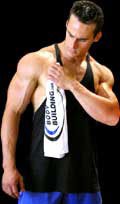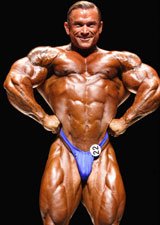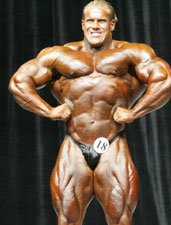Creatine
Overview:
Creatine is a naturally occurring amino acid (protein building block) found mainly in muscles. Fifty percent of creatine in our bodies is ingested through the foods we eat while the other 50% is made in the liver, kidney, and pancreas. Roughly one-third is in its free form as creatine, while the remainder is bound to phosphate and called creatine phosphate or phosphocreatine. During high-intensity, short-duration exercise, such as lifting weights or sprinting, phosphocreatine is broken down into creatine and phosphate. The energy released in this process is used to regenerate ATP, a major source of energy within the human body that drives a number of biological processes including muscle contraction and protein production.
Creatine supplements have gained much popularity in recent years, particularly among body builders and competitive athletes. In fact, as many as 4% of Americans have taken a sports enhancing supplement. Estimates ranging from $45 - $1.4 billion dollars are spent on sports related supplements each year, including roughly $14 million on creatine specifically. The attraction of creatine, again, is that it may enhance athletic performance, particularly during high-intensity, short-duration sports (like high jumping and weight lifting).
However, not all human studies have confirmed this beneficial response and not every individual responds positively to creatine supplements. For example, people who tend to have naturally high stores of creatine in their muscles will not experience an energy-boosting effect from extra creatine. Preliminary clinical studies also suggest that creatine's ability to increase muscle mass and strength could hold special advantages for combating muscle weakness associated with various neuromuscular disorders.
Uses:
Athletic performance
Although not all clinical studies agree, some conducted in both animals and people have shown that creatine supplements improve strength and lean muscle mass during high-intensity, short-duration exercises (such as weight lifting). These positive effects were mainly seen in young people (roughly 20 years of age). Also, creatine along with resistance training has been reported to increase bone mineral density in elderly individuals, thereby reducing the risk for osteoporosis. Although it does not appear to improve physical endurance, there is some suggestion that speed for short periods of time may improve with use of creatine.
The use of creatine for athletic performance, however, is controversial and its use is restricted by several athletic organizations. The National Collegiate Athletic Association (NCAA), for example, prohibits member schools from giving creatine and other muscle building supplements to their athletes. The French Agency of Medical Security for Food (AFSSA) asserts that the use of creatine supplements is "against the spirit of sportsmanship and fair competition." The Healthy Competition Foundation, a nonprofit organization founded by the Blue Cross and Blue Shield Association to educate the public about the risks of performance-enhancing drugs in athletic competition, "urges abstinence from creatine use and reminds athletes, coaches, and parents that skill, dedication and hard work are the most important qualities for success in sports…"
In addition, there is concern about athletes taking pure creatine supplements because of the potential for serious side effects such as damage to the kidneys in otherwise healthy people and the risk of inhibiting the body's natural formation of creatine. Some suggest that the solution is to only use creatine as part of a complex sport nutritional supplement that includes other exercise enhancing substances but this theory has yet to be tested.
Also of concern is the marketing of creatine containing supplements directly to teens. This age group is particularly vulnerable to the enticing but misleading claims about changing one's body shape with little effort. One survey conducted with college students found that teen athletes frequently exceed the recommended loading and maintenance doses of creatine. Meanwhile, neither safety nor effectiveness in those under 19 has ever been tested.
Neuromuscular disorders
Neuromuscular disorders refers to a group of conditions characterized by muscle weakness and wasting. They are caused by either a problem in the muscles themselves or as a consequence of a dysfunction of the nerves responsible for making muscles move. Examples include muscular dystrophy, amyotrophic lateral sclerosis (ALS, often referred to as "Lou Gehrig's disease" and characterized by progressive loss of control of voluntary muscles due to destruction of nerve cells in the brain and spinal cord), and McArdle's disease (a disease characterized by abnormal storage of glycogen [a form of energy made from the sugar glucose] in muscle tissue leading to muscle pain, cramps, stiffness and poor exercise tolerance).
Given that some studies suggest that creatine supplements may improve exercise performance in athletes, researchers have asked the question of whether this benefit may be conferred to people with neuromuscular disorders as well. Preliminary research in people and animals suggests that creatine supplementation for short periods of time (generally, 5 - 7 days) may improve muscle strength, increase lean body mass, and enhance exercise performance in those with neuromuscular disorders. Long-term, well-designed trials are needed.
Parkinson's disease
People with Parkinson's disease (PD) have decreased muscular fitness including decreased muscle mass, muscle strength, and increased fatigue (excessive tiredness). A small clinical study found that giving creatine to individuals with PD improved their exercise ability and endurance. In another clinical study, creatinine supplementation improved PD patient moods and led to a smaller dose increase of drug therapy. More research is needed in this area.
Heart disease
A preliminary clinical study suggests that creatine supplements may help lower levels of blood lipids (cholesterol) in men and women with abnormally high concentrations of lipids in their blood.
In a few clinical studies of people with heart failure (HF), those who took creatine (in addition to standard medical care) had significant improvement in symptoms and exercise capacity compared to those who received placebo. One clinical study in 20 patients with HF found that short-term creatine supplementation in addition to standard medication lead to an increase in body weight and an improvement of muscle strength.
Creatine has also been reported to help lower levels of homocysteine. Homocysteine is a marker of potential heart disease, including heart attack and stroke.
Other
Some preliminary clinical evidence from animal studies suggests that creatine may prove beneficial after brain injury from trauma (such as after a car accident) by preserving brain function. It is premature to draw conclusions for people from this information. This potential application of creatine requires further research.
Similarly, one clinical study of a small number of people with rheumatoid arthritis examined whether creatine could help combat muscle weakness, a common complication of this joint disorder. Muscle strength did improve in 8 of the 12 participants in the study. However, the authors concluded that the data was not strong enough yet to draw definite conclusions for those with rheumatoid arthritis. More research will be useful.
Several clinical studies have found that creatine supplementation improves mood and ability to perform tasks in sleep-deprived individuals.
Dietary Sources:
Approximately 50% of creatine in our bodies is made from other amino acids in the liver, kidney and pancreas, while the other 50% is ingested through the foods we eat. Wild game is considered to be the richest source of creatine, but lean red meat and fish (particularly herring, salmon, and tuna) are also good sources.
Available Forms:
Supplements are commonly sold in powder form, although liquid preparations, tablets, capsules, energy bars, fruit-flavored chews, drink mixes, and other preparations are also available.
How to Take It:
Pediatric
Despite the growing numbers in grades 6 through 12 using creatine, safety and effectiveness have not been tested in those under 19. Therefore, use of creatine supplements is not recommended for children or teens.
Adult
Loading dose in exercise performance (for adults ages 19 and older): Take 5 grams of creatine monohydrate, 4 times daily (20 grams total daily) for one week.
Maintenance dose in exercise performance (for adults ages 19 and older): Take 2 - 5 grams daily.
For cholesterol reduction (for adults ages 19 and older): Take 20 - 25 grams daily, for 5 days, followed by 5 - 10 grams daily thereafter.
It appears that the absorption of creatine is enhanced when it is taken together with carbohydrate foods (such as fruits, fruit juices, and starches). The doses mentioned have been tested frequently in athletes. It is important to note, however, that it is not known whether these dosages have the same effects in non-athletes.
Precautions:
Because of the potential for side effects and interactions with medications, dietary supplements should be taken only under the supervision of a knowledgeable health care provider.
Side effects of creatine include weight gain, muscle cramps, muscle strains and pulls, stomach upset, diarrhea, dizziness, high blood pressure, liver dysfunction, and kidney damage. The weight gain is thought to be due primarily to water retention. Rhabdomyolysis (breakdown of skeletal muscle tissue) and acute kidney failure was reported in one case involving an athlete taking over 10 grams daily of creatine for 6 weeks. Creatine should not be used by anyone who already has problems kidney function, high blood pressure, or liver disease. Taking creatine supplements may prevent the body from making its own natural stores. The long-term consequences of this are not known.
A 2001 report by the Food Safety Agency of France (AFSSA) raised questions about creatine supplements possibly putting users at greater risk for cancer, particularly if such supplements are taken for long periods of time. However, the European Commission and the Council for Responsible Nutrition in the United States both determined that AFSSA's claims are unsubstantiated and not based on any scientific evidence of a connection between creatine and cancer. All 3 organizations do agree, though, that risks of long-term use of creatine are not known at this time.
Creatine supplements containing contaminants from the production process have been reported. Be sure to buy products made by established companies with good reputations, and who distribute their products through trustworthy and knowledgeable establishments.
Possible Interactions:
If you are currently being treated with any of the following medications, you should not use creatine without first talking to your health care provider.
Cimetidine, diuretics, NSAIDs, and probenecid -- Creatine may increase the likelihood of damage to the kidneys if taken with cimetidine (Tagamet, a medication used for heartburn and to prevent ulcers), diuretics, probenecid (used for gout), or non-steroidal anti-inflammatory (NSAID) medications (such as ibuprofen or Advil).
Other substances -- The combined use of caffeine, ephedra (a very concerning substance once found in sports or weight loss supplements that was banned in 2004), and creatine has been associated with at least one report of a stroke in a male weight lifter. It is believed that the combination of creatine with herbs and medications that stimulate the central nervous system contributed to the stroke.
Alternative Names:
Phosphocreatine
* Reviewed last on: 6/7/2007
* Ernest B. Hawkins, MS, BSPharm, RPh, Health Education Resources; and Steven D. Ehrlich, N.M.D., private practice specializing in complementary and alternative medicine, Phoenix, AZ. Review provided by VeriMed Healthcare Network.
Supporting Research
Andrews R, Greenhaff P, Curtis S, Perry A, Cowley AJ. The effect of dietary creatine supplementation on skeletal muscle metabolism in congestive heart failure. Eur Heart J. 1998;19(4):617-622.
Beck TW, Housh TJ, Johnson GO, Coburn JW, Malek MH, Cramer JT. Effects of a drink containing creatine, amino acids, and protein combined with ten weeks of resistance training on body composition, strength, and anaerobic performance. J Strength Cond Res. 2007;21(1):100-4.
Bender A, Koch W, Elstner M, et al., Creatine supplementation in Parkinson disease: a placebo-controlled randomized pilot trial. Neurology. 2006;67(7):1262-4.
Benzi G. Is there a rationale for the use of creatine either as nutritional supplementation or drug administration in humans participating in a sport? Pharmacol Res. 2000;41(3):255-264.
Bosco C, Tihanyi J, Pukspk J. Effect of oral creatine supplementation on jumping and running performance. Int J Sports Med. 1997;18:369–372.
Chilibeck PD, Chrusch MJ, Chad KE, Shawn Davison K, Burke DG. Creatine monohydrate and resistance training increase bone mineral content and density in older men. J Nutr Health Aging. 2005;9(5):352-3.
Earnest CP, Almada AL, Mitchell TL. High-performance capillary electrophoresis: pure creatine monohydrate reduces blood lipids in men and women. Clin Sci. 1996;91:113–118.
Eckerson JM, Stout JR, Moore GA, Stone NJ, Iwan KA, Gebauer AN, Ginsberg R. Effect of creatine phosphate supplementation on anaerobic working capacity and body weight after two and six days of loading in men and women. J Strength Cond Res. 2005;19(4):756-63.
Edmunds JW, Jayapalan S, DiMarco NM, Saboorian MH, Aukema HM. Creatine supplementation increases renal disease progression in Han:SPRD-cy rats. Am J Kidney Dis. 2001;37(1):157-159.
Ferraro S, Codella C, Palumbo F. Hemodynamic effects of creatine phosphate in patients with congestive heart failure: a double-blind comparison trial versus placebo. Clin Cardiol. 1996;19(9):699-703.
Field ML. Creatine supplementation in congestive heart failure. Cardiovasc Res. 1996;31(1):174-176.
Francaux M, Poortmans JR. Effects of training and creatine supplement on muscle strength and body mass. Eur J Appl Physiol Occup Physiol. 1999;80(2):165-168.
Graham AS, Hatton RC. Creatine: a review of efficacy and safety. J Am Pharm Assoc. 1999;39(6):803-810.
Green AL, Hultman E, Macdonald IA, Sewell DA, Greenhaff PL. Carbohydrate ingestion augments skeletal muscle creatine accumulation during creatine supplementation in humans. Am J Physiol. 1996;271(5 Pt 1):E821-826.
Green AL, Simpson EJ, Littlewood JJ, Macdonald IA, Greenhaff PL. Carbohydrate ingestion augments creatine retention during creatine feeding in humans. Acta Physiol Scand. 1996;158(2):195-202.
Grindstaff PD, Krieder R, Bishop R, et al. Effects of creatine supplementation on repetitive sprint performance and body composition in competitive swimmers. Int J Sport Nutr. 1997;7:330–346.
Groeneveld GJ, Beijer C, Veldink JH, Kalmijn S, Wokke JH, van den Berg LH. Few adverse effects of long-term creatine supplementation in a placebo-controlled trial. Int J Sports Med. 2005;26(4):307-13.
Hass CJ, Collins MA, Juncos JL. Resistance training with creatine monohydrate improves upper-body strength in patients with Parkinson disease: a randomized trial. Neurorehabil Neural Repair. 2007;21(2):107-15.
Juhn MS, O'Kane JW, Vinci DM. Oral creatine supplementation in male collegiate athletes: a survey of dosing habits and side effects. J Am Diet Assoc. 1999;99(5):593-595.
Juhn, MS, Tarnopolsky M. 1998. Potential side effects of oral creatine supplementation: a critical review. Clin J Sport Med. 1998;8:298–304.
Juhn, MS, Tarnopolsky M. Oral creatine supplementation and athletic performance: a critical review. Clin J Sport Med. 1994;8:286–297.
Klivenyi P, Ferrante RJ, Matthews RT, et al. Neuroprotective effects of creatine in a transgenic animal model of amyotrophic lateral sclerosis. Nature Medicine. 1999;5(3):347-350.
Korzun WJ. Oral creatine supplements lower plasma homocysteine concentrations in humans. Clin Lab Sci. 2004;17(2):102-6.
Kreider RB. Dietary supplements and the promotion of muscle growth with resistance exercise. Sports Med. 1999;27(2):97-110.
Kreider RB, Ferreira M, Wilson M, et al. Effects of creatine supplementation on body composition, strength and sprint performance. Med Sci Sports Exerc. 1998;30(1):73–82.
Lawrence SR, et al. The effect of oral creatine supplementation on maximal exercise performance in competitive rowers. Sports Medicine, Training and Rehabilitation. 1997;7:243–253.
McMorris T, Harris RC, Swain J, et al., Effect of creatine supplementation and sleep deprivation, with mild exercise, on cognitive and psychomotor performance, mood state, and plasma concentrations of catecholamines and cortisol. Psychopharmacology (Berl). 2006;185(1):93-103.
McNaughton LR, Dalton B, Tarr J. The effects of creatine supplementation on high–intensity exercise performance in elite performers. Eur J Appl Physiol. 1998;78:236–240.
Metzl JD, Small E, Levine SR. Gershel JC. Creatine use among young athletes. Pediatrics. 2001;108(2):421-425.
Odland LM, MacDougall JD, Tarnopolsky MA, Elorriaga A, Borgmann A. Effect of oral creatine supplementation on muscle [PCr] and short-term maximum power output. Med Sci Sports Exerc. 1997;29:216–219.
Poortmans JR, Auquier H, Renaut V, Durussel A, Saugy M, Brisson GR. Effect of short-term creatine supplementation on renal responses in men. Eur J Appl Physiol. 1997;76:566–567.
Prevost MC, Nelson AG, Morris GS. Creatine supplementation enhances intermittent work performance. Res Q Exerc Sport. 1997;68:233–240.
Rawson ES, Wehnert ML, Clarkson PM. Effects of 30 days of creatine ingestion in older men. Eur J Appl Physiol Occup Physiol. 1999;80(2):139-144.
Schneider DA, McDonough PJ, Fadel PJ, Berwick JP. Creatine supplementation and the total work performed during 15-s and 1-min bouts of maximal cycling. Aust J Sci Med Sport. 1997;29:65–68.
Sheth NP, Sennett B, Berns JS. Rhabdomyolysis and acute renal failure following arthroscopic knee surgery in a college football player taking creatine supplements. Clin Nephrol. 2006;65(2):134-7.
Silber ML. Scientific facts behind creatine monohydrate as sport nutrition supplement. J Sports Med Phys Fitness. 1999;39(3):179-188.
Smith, J.C., et al. Effect of oral creatine ingestion on parameters of the work rate-time relationship and time to exhaustion in high-intensity cycling. Eur J Appl Physiol. 1998;77:360–365.
Sullivan PG, Geiger JD, Mattson MP, Scheff SW. Dietary supplement creatine protects against traumatic brain injury. Ann Neurol. 2000;48(5):723-729.
Tarnopolsky MA, Beal MF. Potential for creatine and other therapies targeting cellular energy dysfunction in neurological disorders [Review]. Ann Neurol. 2001;49(5):561-74.
Tarnopolsky M, Martin J. Creatine monohydrate increases strength in patients with neuromuscular disease. Neurology. 1999;52(4):854-858.
Thompson CH, et al. Effect of creatine on aerobic and anaerobic metabolism in skeletal muscles in swimmers. Br J Sports Med. 1996;30:222–225.
Tyler TF, Nicholas SJ, Hershman EB, Glace BW, Mullaney MJ, McHugh MP. The effect of creatine supplementation on strength recovery after anterior cruciate ligament (ACL) reconstruction: a randomized, placebo-controlled, double-blind trial. Am J Sports Med. 2004;32(2):383-8.
Vahedi K, Domingo V, Amarenco P, Bousser MG. Ischemic stroke in a sportsman who consumed Ma Huang extract and creatine monohydrate for body building. J Neurol Neurosurg Psychiatry. 2000;68:100-126.
Vandenberghe K, Gillis N, Van Leemputte M, Van Hecke P, Vanstapel F, Hespel P. Caffeine counteracts the ergogenic action of muscle creatine loading. J Appl Physiol. 1996;80:452–457.
Vandenberghe K, Goris M, Van Hecke P, Van Leemputte M, Vangerven L, Hespel P. Long-term creatine intake is beneficial to muscle performance during resistance training. J Appl Physiol. 1997;83:2055–2063.
Vandebuerie F, Vanden Eynde B, Vandenberghe K, Hespel P. Effect of creatine loading on endurance capacity and sprint power in cyclists. Int J Sports Med. 1998;19:490–495.
Volek JS, Kraemer WJ, Bush JA, et al. Creatine supplementation enhances muscular performance during high-intensity resistance exercise. J Am Diet Assoc. 1997;97:765–770.
Volek JS, Duncan ND, Mazzetti SA, et al. Performance and muscle fiber adaptations to creatine supplementation and heavy resistance training. Med Scien Sports Exer. 1999;31(8):1147-1156.
Willer B, Stucki G, Hoppeler H, Bruhlmann P, Krahenbuhl S. Effects of creatine supplementation on muscle weakness in patients with rheumatoid arthritis. Rheumatology. 2000;39(3):293-298.
Witte KK, Clark AL, Cleland JG. Chronic heart failure and micronutrients. J Am Coll Cardiol. 2001;37(7):1765-1774.
The information provided herein should not be used during any medical emergency or for the diagnosis or treatment of any medical condition. A licensed medical professional should be consulted for diagnosis and treatment of any and all medical conditions. Call 911 for all medical emergencies. Links to other sites are provided for information only -- they do not constitute endorsements of those other sites. © 1997- 2010 A.D.A.M., Inc. Any duplication or distribution of the information contained herein is strictly prohibited.
 Worst Water
Worst Water Worst Bottled Tea
Worst Bottled Tea
 Worst Frozen Fruit Drink
Worst Frozen Fruit Drink Worst “Health” Drink in America
Worst “Health” Drink in America







 Think about the upper arm-bone. The pec attaches perhaps 1.5 inches away from the base of the bone, near the shoulder-joint. When you're pressing weights, you have biomechanics working against you (it's like holding a short bar with one hand at the very end!
Think about the upper arm-bone. The pec attaches perhaps 1.5 inches away from the base of the bone, near the shoulder-joint. When you're pressing weights, you have biomechanics working against you (it's like holding a short bar with one hand at the very end!








